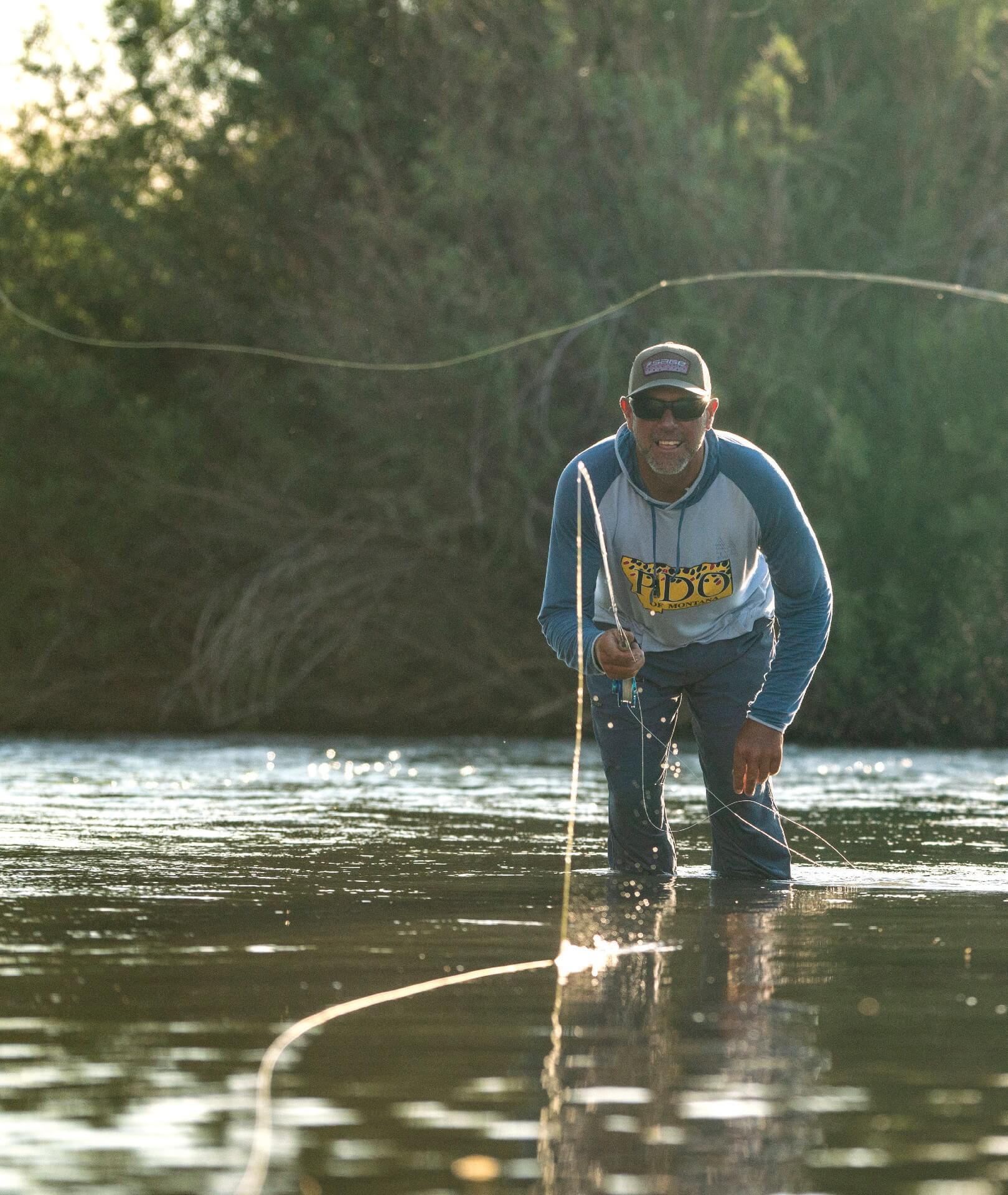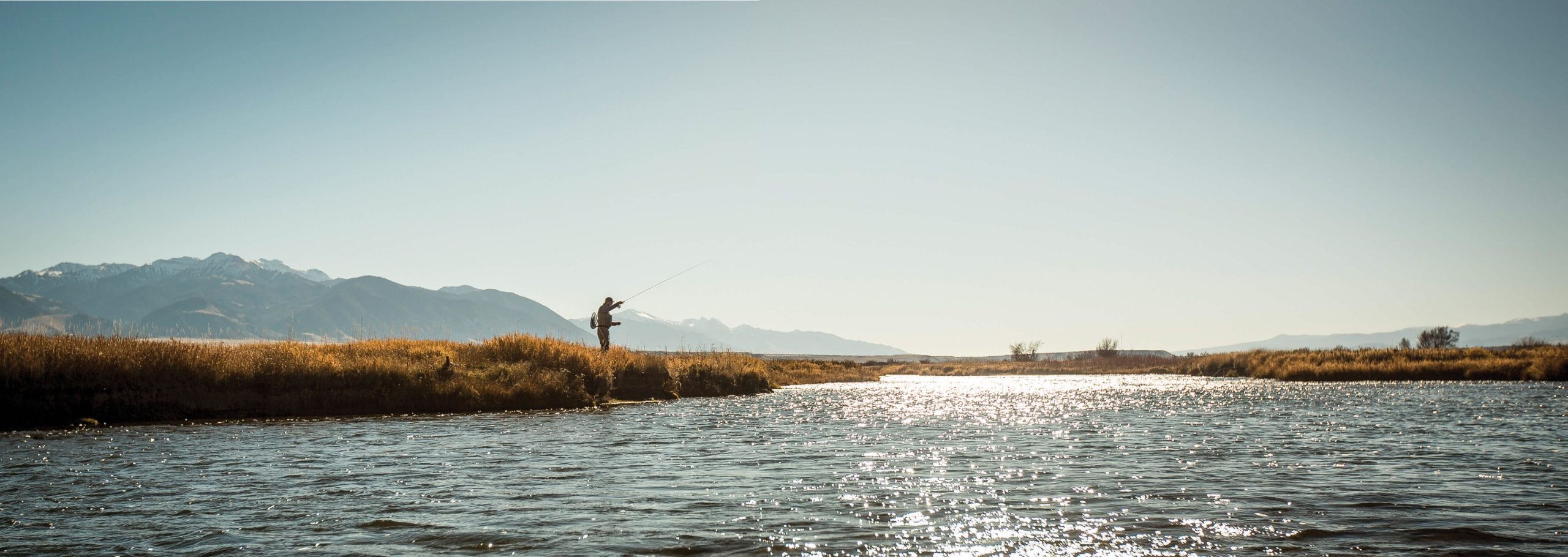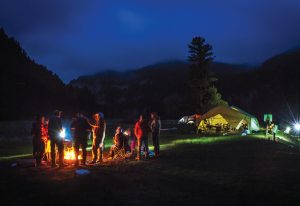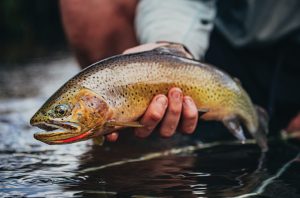
01 Jun Fly Rod Central
Migrating flocks of northbound geese overhead. Retreating snowlines and the first blush of green on the hillsides. Newborn calves in the fields. Not long ago, those were the Bozeman area’s reliable signs of spring, assuring us that we had survived yet another cold Montana winter.

Dan Bailey’s famous Livingston, Montana-based fly shop was the area’s first. Note the “Wall of Fame” in the background, displaying outlines of exceptionally large trout. Photography by Melanie Maganias
Nowadays, other elements mark that seasonal transition. By April, every truck in town seems to be dragging an object that might look foreign to newcomers unfamiliar with the outline of a McKenzie River boat. Visitors clutching fly-rod tubes choke the Bozeman airport, and high-end sunglasses dangle from straps around just about every neck. Another fly-fishing season in southwest Montana has begun.
Around the Gallatin Valley, many of the billboards portray angling — always fly fishing specifically — though most of the businesses have nothing to do with the sport other than having a location in Bozeman. At least in terms of magnitude, the new regional fly-fishing scene is — I can’t think of a better word to describe it — a phenomenon. When I started fishing the area’s blue-ribbon streams as a kid back in the 1950s, none of this existed. Fishing with a fly rod rather than conventional tackle was enough to draw stares and questions. This leads us to the questions examined in this story: What happened — how and why — and what do these developments mean for the future of the region?
Two characteristics of this phenomenon warrant explanation from the start. The flood of visitors and the services they support aren’t just about fishing; they’re about fly fishing, and the distinction is an important one because it defines needs and interests in a specific way. Why the explosion of interest in what was, not all that long ago, just a diversion for a few eccentrics? Perhaps, as some cynics suggest, it really was The Movie — “A River Runs Through It,” adapted from the story by Norman Maclean — that transformed fly fishing from relative obscurity to mainstream recreation. Perhaps a lot of people simply discovered that standing in the water waving a stick, as writer John Gierach puts it, offers a relaxing, fulfilling way to spend a day.
The second characteristic involves the focus of all this attention: trout, the quarry with which fly fishing began and remained for decades. Although as the sport gained popularity, innovators expanded the target options to include warm water species like bass and pike, along with the brave new world of saltwater fly fishing, little of which matters here. If the Missouri headwaters didn’t offer the country’s best trout fishing, Bozeman wouldn’t be the Bozeman it has become.

Photography by John Frazier
Humans have been hauling fish from the water since the dawn of recorded history, utilizing the catch as a ready food source. The idea of fishing for enjoyment, however, is a more recent development. Around the time Columbus set off for the New World, Dame Juliana Berners began writing about recreational angling in England — with flies, no less (and yes, it’s gratifying to note that women have been involved since the beginning).
American fly fishing began on the Eastern Seaboard in the late 1800s thanks to pioneers whose names remain familiar today: Charles Orvis, who founded the Orvis Company in 1856; Theodore Gordon, who popularized dry-fly fishing and created enduring fly patterns like the Quill Gordon; and Hiram Leonard, whose split bamboo rods are now valuable collector’s items. At the time though, no one thought much about recreational fly fishing west of the Mississippi.
Slowly, that began to change. In the 1920s, best-selling author Zane Grey frequently wrote about steelhead fishing in Oregon, and fly casting developed into a competitive sport in California. In 1936, angler and academic physicist Dan Bailey moved West, opening his iconic fly shop in Livingston, Montana two years later. Then came the explosion of interest in outdoor recreation that followed the end of World War II. In 1961, Bud Lilly opened his West Yellowstone fly shop and guiding service. By then, innovative fly tiers like Lee Wulff were developing large, buoyant patterns especially suited to Western rivers. And the rest is history.
But why, out of all the Mountain West’s scenic, fish-rich waters, did the ones in southwest Montana become so popular? In Guns, Germs, and Steel: The Fates of Human Societies, Jared Diamond persuasively argues that geography determines human culture, and that some societies became dominant because they arose in places that offered an ideal combination of climate, terrain, and wildlife suitable for domestication. So, here lies Bozeman, situated within easy driving distance of over a dozen great trout streams ranging from big, fast-moving rivers to delicate little spring creeks — great not only because of the size and number of fish they support, but also because of the aesthetic appeal of fishing them.
While our regional geography upholds the relevance of Diamond’s thesis to fly fishing, the fish themselves do not. He points out that the Fertile Crescent, where so much human civilization began, was home to plants that became grain and animals that became livestock. Ironically, while the Missouri headwaters contain splendid fish habitat, it wasn’t its status as a home to the fish that made it famous.


Producing products for anglers across the country, Simms employs 150 people. Many, like Jason Hankins (left), specialize in sewing the company’s highly regarded waders, which is done on site in their Bozeman warehouse. Photos Courtesy John Frazier/Simms Fishing Products
The cutthroat is Montana’s only native trout. While fly anglers admire it, the cutthroat does not fare well in the face of competition from introduced species, and it accounts for a relatively small proportion of the area’s recreational catch. Brook trout — a staple in East Coast recreational fisheries — were successfully introduced to Montana in 1889, but their habitat preferences for small mountain streams limit their appeal as a target species here.
Anglers visit the Missouri headwaters to catch brown and rainbow trout, neither of which is indigenous to the area. Brown trout are a European species first introduced to the upper Madison River in 1889. Rainbows originated in the tributaries of the Pacific and were transplanted to the headwaters of the Missouri around the same time. Both thrived in their new environments (unfortunately for native cutthroats). Thus, the biological paradox of Montana’s most successful recreational fishery: Neither of the two species that made the area’s reputation really belong here.
Social factors are just as important as biology in the development of our regional fly-fishing scene, and they tend to become self-perpetuating. Imagine a traditional small town in rural Montana, add some well-heeled visitors, and soon the local bar becomes an upscale restaurant. Amenities attract more visitors, who in turn support more amenities, and eventually, you have, well, Bozeman. The same phenomenon applies to fly fishing.
While Dan Bailey’s Livingston fly shop may have been the area’s first, today nearly a dozen operate in Bozeman alone. For a community of its size, Bozeman is also home to a remarkable number of companies that make highly regarded outdoor products, ranging from backpacks and hiking boots to waders and specialized outdoor clothing. (I would also posit that the Bozeman area has the country’s highest per capita population of outdoor writers and photographers.) Whatever old-timers may think of the newly gentrified scene, its importance to the local economy is undeniable.

On trips with Bozeman-based Yellow Dog Flyfishing Adventures, guides and clients often have lively chats around the evening fire. Courtesy of Jim Klug/Yellow Dog FlyFishing adventures.
Since input from some members of the new fly-fishing economy seemed relevant, I recently sat down with John Frazier of Simms Fishing Products. He explained that a man by the name of John Simms started the business in Wyoming in 1980, focusing on manufacturing waders. In 1993, new owner K.C. Walsh moved the company to Bozeman due to the fact that it was, as he’s stated, “considered by many as the fly-fishing capital of the U.S.,” and also because of the growing guide community and the proximity to so many outstanding trout streams (a point in support of Diamond’s geographic hypothesis). Today, Simms employs 165 residents (65 of whom make waders on site), a substantial number even in the face of Bozeman’s growth spurt. While Simms now makes a variety of quality products, including clothing, waterproof packs and bags, and boots, among other things, their waders — widely regarded for their comfort and durability — remain the company’s flagship product.
Frazier identified Simms’ knowledgeable, enthusiastic workforce as a significant benefit to the company’s Bozeman location, especially since many staff members moved to the area for the abundant outdoor recreation and trout-filled rivers. He also explained their unique policy that allows employees time off on Fridays, as long as they spend it fishing (talk about a tough job requirement!). “Fishing Fridays,” which must be one of the country’s most imaginative employee perks, has been part of the Simms culture since 2014, and Frazier credits it with boosting morale while allowing employees to bond and brainstorm during the strain of the pandemic.
I also visited with Jim Klug, founder and director of the Bozeman-based Yellow Dog Flyfishing Adventures, a destination travel company that plans trips for anglers to some 250 locales in 29 different countries. When asked why an international booking agency would choose to operate in what is still a relatively off-the-beaten-path location, he expressed several points in common with what I’d heard from Frazier, emphasizing the quality and commitment of the workforce. Bozeman’s status as a fly-fishing mecca has attracted a population of young people who both love the sport and know it well — two crucial qualities in employees working in a field this specialized.

First described by members of the Lewis & Clark Expedition, the cutthroat is the only trout native to the Missouri headwaters. Photography by Jess McGlothlin
We also shared thoughts on a rare area of controversy in the sport that presents itself as an antidote to stress and conflict. Many now worry that this newfound love of fly fishing has the potential to love it to death. The uncrowded pace of the fishing I enjoyed as a kid is now gone forever. My wife Lori, a fifth-generation Montanan and accomplished fly-rod angler, graduated from Montana State University in Bozeman with a degree in nursing. When she arrived for her first day of college, she found a cow tied to a tree outside her dorm beneath a sign that read, “Welcome to Moo U.” Thirty years later, she came home from Bozeman on the verge of tears because an impatient driver had blown his horn at her — something she had never experienced in Montana before. These two vignettes could serve as bookends defining the changes that have taken place in Bozeman over the years. Such are the wages of growth.
Rather than dancing around the issue, Frazier and Klug both addressed it head-on. While they too enjoy uncrowded waters, they agreed that the real threat to the future of fly fishing doesn’t come from more anglers, but from the decline in habitat that gamefish require. Klug cited the ongoing battle over the future of the Tongass National Forest in southeast Alaska, an area of particular interest to me since I used to live there. Years of poorly regulated logging (which actually cost American taxpayers money) compromised the streams upon which both recreational and commercial fishing — in addition to the area’s growing tourism economy — depend. Keeping the Tongass and the sustainable businesses it supports intact will require determined political effort by various stakeholders, especially anglers — the more the better, even if that means more people on some of my favorite wilderness streams.
Diminishing fishery habitats is an issue that companies like Yellow Dog and Simms take seriously, and like many others in the industry, they are taking a proactive approach to help. Klug and his staff started the Yellow Dog Community and Conservation Fund, which has raised over a million dollars for community development and habitat improvement in the remote — and in some cases impoverished — destinations to which they send anglers. Among other accomplishments, this program led to a ban on gillnetting in Belize — a big win for fish that wouldn’t have happened without support from fly-rod anglers.
Simms has partnered with Trout Unlimited — a $250,000 commitment over three years — for their Home Rivers Initiative “to help protect and preserve our beloved Gallatin River,” Frazier says. “We’re also heavily involved in striped bass conservation efforts most recently, and for years, we’ve worked with various other philanthropic organizations, such as Casting for Recovery and Warriors & Quiet Waters.”
Navigating between the costs and benefits of growth will require careful negotiation among stakeholders, as is currently taking place on the increasingly crowded Madison River, where a management plan is being constructed. It will also require sportsmanship and common courtesy, along with the realization that we are, ultimately, all in this together.




No Comments